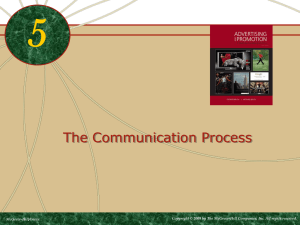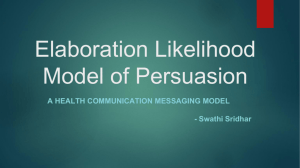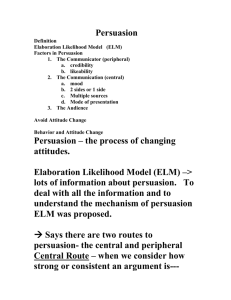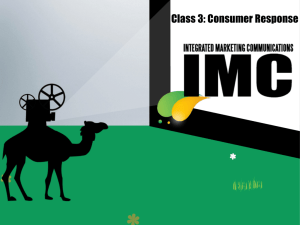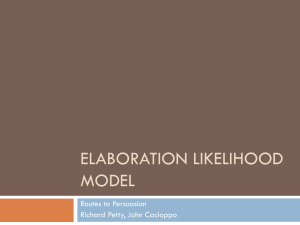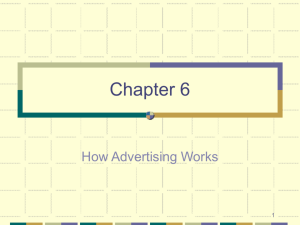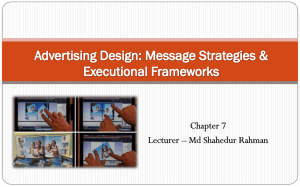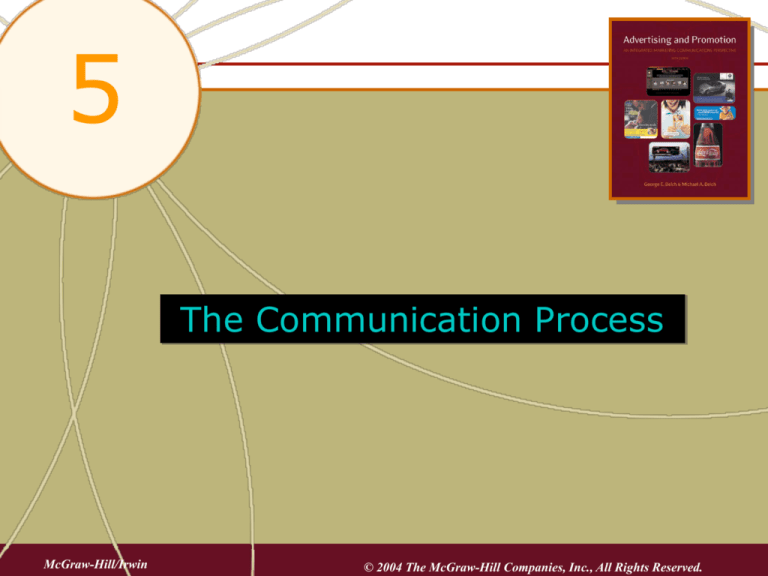
5
The Communication Process
McGraw-Hill/Irwin
5-1
© 2004 The McGraw-Hill Companies, Inc., All Rights Reserved.
What is the symbolic meaning of the Snuggle bear?
5-2
Models of the Response Process
Models
Stages
AIDA
model
Hierarchy Innovation Information
of effects adoption Processing
model
Attention
Cognitiv
Awarenes
e
s
Awarenes Presentatio
s
n
Attention
Interest
Interest
Knowledg
Comprehen
sion
e
Affective
Desire
Yielding
Linking
Evaluation
Similarities / Differences?
Preferenc
Retention5-3
Aaker's 5 - Stages
of Brand Loyalty
Friend
of Brand
Prefers Brand
Likes Brand
Positive Att. toward Brand
Aware of Brand
5-4
Advertising is used to make consumers aware of new
products and their features
Yes, but. . .
Is that what the ad is
REALLY trying to do?
5-5
Involvement Concept
Possible
results of
Elicitation
of
involvement
Antecedents of
involvement
derived from the
literature
Person
factors Needs
Importanc
Object
e - or stimulus
factors
Interest Differentiation
of
- Values
alternatives
- Source of
communication
–
Situational
Content
factors of
communication
-Purchase/use
-Occasion
counterarguments to
ads
Involvement
Effectiveness of ad to
induce purchase
Relative importance of
the product class
With
advertisements
With products
With purchase
decisions
Perceived differences
in product attributes
Preference of a
particular kind
Influence of price on
brand choice
Amount of information
on search
Time spend
deliberating alternatives
Type of decision rule
used in choice
5-6
The Elaboration Likelihood Model
Focuses on the way consumers respond to
persuasive messages based on the amount and
nature of elaboration or processing of information
Routes to attitude change
Central route to persuasion – ability and motivation
to process a message is high and close attention is
paid to message content
Peripheral route to persuasion – ability and
motivation to process a message is low and receiver
focuses more on peripheral cues rather than
message content
5-7
Elaboration Likelihood Model (ELM)
HIGH
LOW
E.L Continuum
Peripheral Processing
Central Processing
# of Arguments
Arg. Quality
Spokesperson Effects
Attribute-Based
Processing
Music
Imagery
Category-Based Processing
Motivation + Ability = Central Processing
5-8
High Involvement Appeals
• Factual Information
• Hard Data
• Appeals to “Experts”
• Example (Toshiba Laptop)
5-9
5-10
Low Involvement Appeals
• Little or no Factual Information
• Imagery
• Emotional
• Appeals to “Novices”
• Example (Toshiba Slide)
5-11
5-12
EXTRA
If Time!
5-13
New Product Introduction
With / Without Free Sampling
% of Households Buying
Free Sample
Recipients
(16.0%)
Control
Group
(11.4%)
Time in Months
5-14
5-15
Relationship between
Level of Fear and Persuasion
Persuasive Effect
Texting while driving ad.
Level of Fear
5-16
5
The Communication Process
McGraw-Hill/Irwin
Copyright © 2012 McGraw-Hill Companies, Inc., All right reversed
The Nature of Communication
5-18
Source Encoding Using a Celebrity
5-19
Forms of Encoding
Verbal
Graphic
Musical
Animation
5-20
Message Development
Content
Design
Structure
5-21
An Image Can Convey More Than Words
5-22
Communication Channels
Personal
Channels
Word of
Mouth
Personal
Selling
Nonpersonal
Channels
Print
Media
Broadcast
Media
5-23
Marketers Embrace Buzz Marketing
5-24
Apples for Dessert
5-25
Field of Experience Overlap
Different Worlds
Sender
Experience
Receiver
Experience
Moderate Commonality
Sender
Experience
Receiver
Experience
High Commonality
Receiver
Sender
Experience
Experience
Receiver
Experience
5-26
Noise in the Communications Process
5-27
Successful Communication
Select an appropriate source
Develop a properly encoded message
Select appropriate channel for target audience
Receive feedback
5-28
Identifying the Target Audience
Mass Markets and Audiences
Markets Segments
Niche Markets
Individual &
Group
Audiences
5-29
The Response Process
5-30
Obtaining Feedback
Effectiveness Tests
Persuasion Process
Circulation reach
Exposure/ presentation
Listener, reader,
viewer recognition
Attention
Recall, checklists
Comprehension
Brand attitudes,
purchase intent
Message acceptance/
yielding
Recall over time
Retention
Inventory, POP,
scanner data
Purchase behavior
5-31
Alternative Response Hierarchies
High
Low
Perceived product
differentiation
Topical Involvement
High
Low
Learning
model
Low involvement
model
Cognitive
Affective
Conative
Cognitive
Dissonance/
attribution model
Conative
Conative
Affective
Cognitive
Affective
5-32
Dissonance/Attribution Model
5-33
Low-Involvement Products
5-34
Low
Involvement
High
Involvement
The FCB Planning Model
Thinking
Feeling
1
2
Informative
The Thinker
Affective
The Feeler
3
4
Habit
Formation
The Doer
SelfSatisfaction
The Reactor
5-35
Developing Promotional Strategies
• Ad options based on the FCB grid
• Rational versus emotional appeals
• Increasing involvement levels
• Evaluation of a think-type product on the
basis of feelings
5-36
LG Connects with Consumer Emotions
5-37
Cognitive Response
A method for examining consumers’ cognitive
processing of advertising messages by looking at
their cognitive responses to hearing, viewing, or
reading communications
Examines thoughts that are evoked
by an advertising message
Consumers write down or verbally report
their reactions to a message
5-38
A Model of Cognitive Response
5-39
Cognitive Response Categories
Product/Message Thoughts
Counterarguments
Support arguments
Source-Oriented Thoughts
Source derogation
Source bolstering
Ad Execution Thoughts
Thoughts about
the ad itself
Affect attitude
toward the ad
5-40
Elaboration Likelihood Model (ELM)
Focuses on the way consumers respond to persuasive
messages, based on the amount and nature of elaboration
or processing of information
Routes to Attitude Change
Central route –
ability and
motivation to process
a message is high and
close attention is paid
to message content
Peripheral route –
ability and
motivation to process
a message is low;
receiver focuses more
on peripheral cues
than on message
content
5-41
Test Your Knowledge
The elaboration likelihood model (ELM) proposed two
routes to persuasion, the central route and the
peripheral route. With the peripheral route:
A) The message is more likely to be received
if a celebrity endorser is used
B) The message should lots of information
C) The receiver is viewed as very actively
involved in the communication process
D) The quality of the message claims are
more important than the spokesperson,
headline, pictures, or music
E) The sender is dealing with a highinvolvement buying situation
5-42
Celebrity Endorsers Can be Peripheral Cues
5-43
How Advertising Works
5-44

